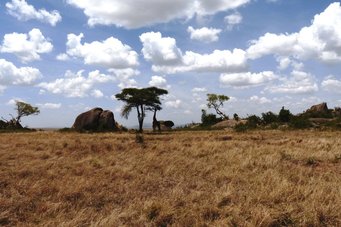Climate change: Savannahs are causing fluctuations in the carbon balance
Variations in the amount of carbon dioxide absorbed by semi-arid ecosystems are causing fluctuations in the global carbon balance

Today, researchers view the earth as a complex system in which the climate is closely linked to the global cycles of various substances, with the carbon balance of the Earth forming a particular focus. Among other things, researchers would like to explain and predict how strongly the amount of carbon dioxide (CO2) will increase in future due to human activity and how this will then influence climate change. The constant rise in CO2 levels in the air is being slowed by vegetation on land, as plants in terrestrial ecosystems are increasing their photosynthesis activity due to the higher CO2 concentration in the air. Therefore, vegetation and the ground are converting more carbon dioxide into biomass than they are releasing again through cell respiration. Although wildfire and other rare extreme events release CO2, these are of minor importance on a global and long-term scale. The bottom line is that terrestrial ecosystems operate as so-called carbon sinks. According to calculations, terrestrial vegetation absorbs around a quarter of the anthropogenic CO2 emissions over the long-term average and thereby helps protect the climate.
However, the amount of carbon that terrestrial ecosystems absorb and release changes from year to year. These fluctuations in the flows of carbon are the primary reason why the CO2 concentration in the atmosphere, which is primarily driven by the burning of fossil fuels, increases much more strongly in some years than in others. But how do these annual fluctuations occur exactly, and which ecosystems contribute most to these variations? Do the changes stem from the same ecosystems that have absorbed the majority of the additional carbon dioxide taken on by vegetation since humans have started the widespread burning of coal, oil and gas?
Savannahs and scrublands surprise researchers
Previous studies indicate that the forests of the tropics and temperate zones have most likely taken in the majority of the carbon which terrestrial vegetation has absorbed since the start of industrialization. In order to answer these questions more precisely and to differentiate between the contributions of different climatic as well as regional ecosystems, an international research team together with scientists from the Max Planck Institute for Biogeochemistry in Jena performed new calculations: With the help of various global ecosystem models and recorded atmospheric CO2 data, the cooperation partners initially analyzed in which regions vegetation has absorbed more CO2 from the air in the last 30 years and in which regions it has absorbed less. After researchers assigned various vegetation classes such as tropical forests or savannahs to the regions with different CO2 balances, the findings were initially as anticipated: “Forest ecosystems, namely tropical rainforests, as well as forests at our latitudes, make up the largest proportion of the overall CO2 uptake in terrestrial ecosystems,” explains Sönke Zaehle, Group Leader at the Max Planck Institute for Biogeochemistry and one of the authors of the study.
However, the researchers also gained a surprising insight: The annual fluctuations in the amount of carbon dioxide taken on by terrestrial ecosystems worldwide are largely attributable to semi-arid ecosystems, i.e. savannahs and scrubland, absorbing more carbon dioxide in some years than in others. “Although they only contribute one-fifth to the overall carbon sink of terrestrial vegetation, savannahs and scrubland are responsible for around half of the annual fluctuations in the carbon balance of terrestrial ecosystems,” says Markus Reichstein, Director at the Max Planck Institute for Biogeochemistry. The decisive factor in these fluctuations is that the CO2 amount which plants lock in through photosynthesis is strongly dependent on the amount of precipitation, especially in semi-arid areas.
The new findings therefore indicate that savannahs and scrubland regions have a decisive impact on fluctuations in the global CO2 balance; however, these ecosystems have received little scientific attention in this context to date. Co-author Benjamin Smith, Professor for Ecosystem Science at Lund University, Sweden, concludes from this that the study clearly shows how important it is to direct attention in biogeochemical research to savannahs and other relatively arid ecosystems. He adds that these landscapes are typically found in a number of the world’s poorer countries, and have been largely neglected in climate policy discussions to date.











